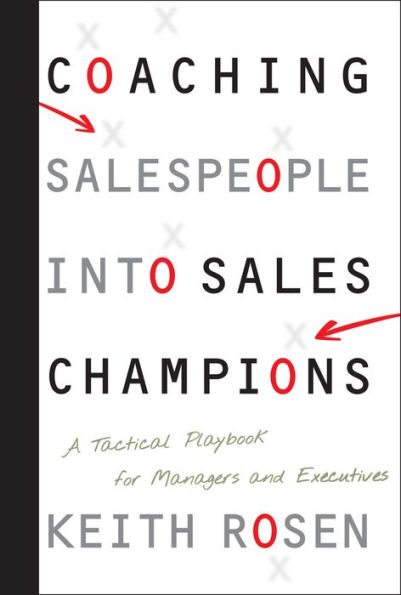Table of Contents
About the Author xiii
Acknowledgments xv
Introduction xvii
Chapter One The Death of Management 1
Becoming an Executive Sales Coach 1
But I’m Already Coaching 3
Making the Shift from Sales Manager to Executive Sales Coach 3
The Missing Discipline of Sales Coaching 5
Defining the Role of a Sales Coach 6
A Coach versus a Mentor 7
Nine Barriers to Coaching a Sales Team 8
Consultant, Trainer, or Coach? 12
Managers Don’t Have Time to Manage 15
Understanding the Commitment to Coach Your Sales Team 17
Get a Coach for the Coach 19
Five Core Characteristics of the World’s Greatest Sales Coaches 21
Chapter Two The Coach’s Mindset: Six Universal Principles of Masterful Coaching 25
Management’s Eternal Conundrum 26
Hitting Rock Bottom 27
You Can’t Coach What You Fear 29
The Strong, Fearful Leader 30
Universal Principle of Masterful Coaching No. 1: Make Fear Your Ally 32
Universal Principle of Masterful Coaching No. 2: Be Present 36
Universal Principle of Masterful Coaching No. 3: Detach from the Outcome 41
Universal Principle of Masterful Coaching No. 4: Become Process Driven 45
Universal Principle of Masterful Coaching No. 5: Be Creative 49
Universal Principle of Masterful Coaching No. 6: Become Fully Accountable— for Everything 50
The Top 19 Excuses Managers Use to Justify Why Salespeople Fail 51
Chapter Three Six Fatal Coaching Mistakes and How to Avoid Them 55
Coach the Relationship with Their Story 56
Fatal Coaching Mistake No. 1: Believing the S.C.A.M.M.— A Manager’s Most Elusive Adversary 57
Fatal Coaching Mistake No. 2: Wanting More for others than They Want for Themselves 63
Fatal Coaching Mistake No. 3: Are You Coaching Your Salespeople or Judging Them? 68
Fatal Coaching Mistake No. 4: Coaching Isn’t about the Coach 70
Fatal Coaching Mistake No. 5: Share Ideas, Not Expectations 71
Fatal Coaching Mistake No. 6: Mismanaging Expectations: Are You Preparing Your Sales Team for Change? 73
Chapter Four Tactical Coaching 77
Who Do You Coach? 77
A.G.R.O.W.T.H. Success Indicator to Determine Personal Coachability 78
Don’t Coach the Squeaker 80
Coaching the Whole Person 80
Developing Sales Champions from the Inside Out 81
What Do You Coach? Coach the Gap 82
Do I Coach Them or Train Them? 84
What Exactly Can You Coach? 88
The Top 10 Characteristics of Highly Effective Salespeople 89
Chapter Five The Seven Types Of Sales Managers 91
The Seven Ps 91
The Problem-Solving Manager 93
The Question is the Answer 97
Solution-Oriented Questions 98
Chapter Six Ignition On! Now They’re Inspired 101
The Pitchfork Manager 101
Push versus Pull— A Simple Model of Motivation 103
Let Your Salespeople Tell You What Motivates Them 104
Ask Your Salespeople How They Want to be Coached 106
Motivate through Pleasure Rather than Consequence 107
Communicate from Abundance Rather than From Scarcity 108
Make Acknowledgment Unconditional, Measurable, and Specific 110
Make Your People Right, Even When They’re Not 113
Create New Opportunities Rather than Make People Wrong 116
Chapter Seven Assumptive Coaching and Dangerous Listening 119
The Pontificating Manager 119
Eight Barriers That Prevent Masterful Listening 121
Listening Through Filters— A Manager’s Lethal Weakness 122
Just the Facts, Please 125
Encourage Silence 125
Focus More on the Message Than on the Messenger 126
Listening to Someone or Listening for Something 127
Make People Feel They Are Being Heard 129
The Presumptuous Manager 131
Don’t Believe Everything You Tell Yourself 132
Get Out of Your Way and Out of Your Head 133
Be Curious 140
Chapter Eight Vulnerability-Based Leadership 143
The Perfect Manager 143
Express Your Authenticity: Become Vulnerable 146
Embrace Your Humanity 147
Evidence of an Emerging Culture 148
Vulnerability and Trust 149
The Passive Manager 151
Embrace Healthy Conflict 153
Call Them Out Using the Coaching Edge 153
Take a Stand for Your Salespeople 154
Declare What You Really Want for Your Sales Team 156
The “I’m Sensing That” Statement 158
The Proactive Manager 161
A View from the Sidelines 162
Chapter Nine Facilitating an Effective Coaching Conversation 169
Preparing for the Coaching Session 169
The Anatomy of a Coaching Session 170
The Coaching Prep Form 171
Strategic Coaching Questions 175
The L.E.A.D.S. Coaching Model 176
The Management Conversation 179
The Coaching Conversation 183
Going Deeper— Breakthrough Coaching 191
How Much Coaching is Enough? 203
Chapter Ten The Art of Enrollment 207
It’s All about Connection 207
Making an Impact 210
Leaving Your Legacy as a Manager 211
The Art of Enrollment 212
Enrollment is a Universal Phenomenon 214
Creating the Possibility for Change 215
The Six Steps of an Enrollment Conversation 216
Case Study: Enrolling Someone to Improve their Quality of Work 218
Case Study: Enrolling Someone to Become More Accountable 222
The Written Word: Crafting a Compelling Message 226
Chapter Eleven The Seduction of Potential 233
Potential is the Holy Grail 233
The Seduction Begins: The Ether of Potential 235
The Hard Cost of Complacency 236
You Can’t Build a Business on Potential 237
When to Give up and Let Go 239
Master the Art of Abandonment 240
The Top Trigger Points of Seduction 241
Chapter Twelve Develop an Internal Coaching Program 243
Identifying a Turnaround Opportunity 244
Holding Your People Accountable 248
Week One: Introducing the Turnaround Strategy—An Enrollment Conversation 248
Week Two: A Minor Setback or Imminent Failure 252
Week Three: On The Winner’s Path 257
Week Four: A Successful Turnaround 264
Designing an Executive Sales Coaching Program 266
How to Turn Around or Terminate an Underperformer in Less than 30 Days 270
Fire Them and Then Hire Them 277
Tips from the Coaches’ Playbook 278
Conclusion 279
Final Thoughts on Being an Executive Sales Coach 279
Appendix 283
The Playbook of Questions for Sales Coaches 283
The 80-20 Rule on Coaching Questions 313
Index 315







